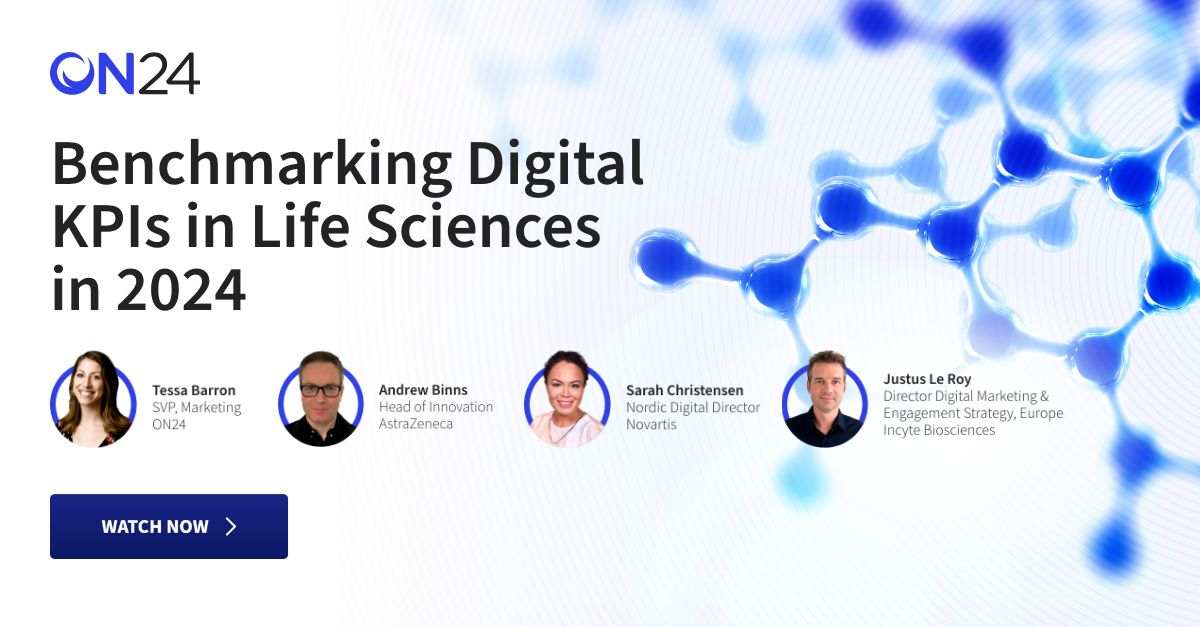Everything, from supply chains and interest rates to regulatory enforcement and more, impacts the pharmaceutical industry’s ability to drive better patient outcomes. That’s why it’s so important for both pharma and life sciences marketers to get digital engagement right.
A well-defined digital engagement strategy provides pharma organizations with the actionable, first-party insights requried to continue conversations, personalize outreach and provide sales reps with the necessary context to connect and help busy healthcare professionals.
That’s why a robust webinar marketing strategy is so important for pharmaceutical companies. With one webinar, marketers can use data, analytics and generative AI to support additional digital marketing channels while simultaneously personalizing experiences for customers and prospects.
engagement trends — to discover some commonalities among how webinar and digital experiences impact HCP engagement.
Here is what we found:
Five Webinar Formats to Boost HCP Marketing Efforts
1. Key Opinion Leader Events

When it comes to healthcare marketing, the most valuable brand asset to have is expert, scientific information from key opinion leaders in specialized fields. With a great KOL, a company can provide thought leadership content and draw in physicians seeking the latest information on their specialty.
To bring KOLs into your webinar strategy, ask subject matter experts — like principal investigators, journal editors and researchers — to participate in an event as a webinar presenter, panelist or moderator. The webinar should focus on a core topic your experts can speak to, such as clinical research, outcomes, cases, medical best practices or current trends in the field.
Be sure to ask your speakers to share the event on their social media platforms. This can help drive registrations and encourage physicians to attend.
2. Digital Symposiums and Congresses

The healthcare industry is no stranger to symposiums. But budgets, availability and travel restrictions all affect whether an HCP attends an event in person.
To overcome this challenge, HCP marketers can provide digital options and enhance their marketing strategy. With a virtual conference solution in place, any enterprising pharmaceutical company can run a virtual version of their big event — making it easier for more healthcare professionals to engage.
Another tactic a pharma marketer can consider is using hybrid event solutions with their virtual event platform. Doing so can provide both virtual and physical attendees engaging experiences that reveal HCP preferences and provide valuable insights while reducing the barriers for attendance.
Virtual symposiums also provide brands with great informative content. If you do run an in-person event, take the time to record sessions and break them into on-demand webinars. With a digital, on-demand symposium in hand, you can enable participants to watch later and maximize your viewership well after the event is over.
3. Product Launches

Marketing at speed is one of the biggest challenges in a healthcare product launch. However, most pharmaceutical marketing material is passive, like product brochures and portfolios. Webinars and virtual events change this dynamic with high-production value, interactive environments that capture audience attention for upwards of an hour.
During this captive time, educate your audience at a deeper level about your new treatment and showcase your product videos and internal experts. Use webinar analytics to discover who amongst your target audience is the most interested based on their active engagement during the presentation. You can also include a “contact us” form in your webinar for interested physicians to raise their hand and instantly request a meeting with a sales representative.
4. Peer-to-Peer Education and Networking

HCPs want to learn from peers and other subject matter experts in their field. But busy schedules and travel restrictions can limit an HCP’s ability to learn, network and engage with other HCPs.
There is a way to overcome typical peer-to-peer hurdles: host virtual events built for them. By creating a digital environment built to educate and facilitate virtual networking, a brand can easily cultivate peer-to-peer education, provide related content to download and use group chat to collect data on these conversations.
And if a group of virtual event attendees has a particular topic they want to explore deeply, HCPs can use webinar features like virtual breakout rooms for a personalized one-to-one discussion.
Launching into a breakout room from a virtual environment is a useful tactic for sales representatives as well. That’s because if an HCP has questions during a presentation or event, a rep can open a direct 1:1 channel — over both video and audio — and directly answer any questions participants may have in real-time.
5. Sales Training

Virtual events empower brands to go in-depth with internal education. Some webinar platforms even provide real-time and certification — ensuring reps meet a brand’s standard. Reps are able to ask and get questions answered in real-time, download additional related content and access this training anytime, anywhere.
According to Docplexus’ ” Pharma’s Guide to a Kickass Marketing Webinar ,” 72% of physicians source drug-related information online, and 78% of physicians favor learning through videos or digital media. Because of this shift, it’s increasingly important for marketers to create a diverse digital program that attracts HCPs, educates them, and keeps them coming back for industry-leading medical information.
Life Sciences Trends Marketers Should Know

It’s not enough to create effective webinar formats. Life sciences and pharma marketers need to pair their digital events with effective tactics and trends. That means understanding the why behind customer and prospect activity — and that means having a plan for personalization in place.
Here’s why.
HCPs are seeking out engaging experiences
According to the 2024 Life Sciences Digital Engagement Benchmarks Report, published by ON24, companies in the life sciences sector see a 20% boost in conversion rates when experiences are personalized. That means HCPs are seeking out information aligning to their specific needs and interests.
Another emerging trend to keep in mind is multi-channel engagement. According to the Life Sciences Digital Engagement Benchmarks Report, HCPs interact with content through a range of channels — from webinars and virtual events to social media, email and more.
This means digital marketers must have an active presence across these channels for effective audience reach. ON24 analytics also revealed a 30% boost in overall engagement with a multi-channel marketing approach, underlining its significance in the life sciences sector.
Engaging experiences require personalization and understanding
Marketers taking a personalized approach to HCPs need to know more than just a name — they need to comprehend an HCP’s distinct needs and preferences. A rheumatologist’s content needs are different than, say, a general practitioner’s.
This is why life sciences marketers need to categorize and segment healthcare professionals according to specialty area, practice and their position in the adoption ladder. Such segmentation enables marketers to deliver relevant personalized content and, crucially, CTAs.
To measure success, prioritize quality engagement
Marketers have to contribute to the bottom line. In the pharma industry, this often means prescription. But the journey to get there — awareness, building trust, understanding pain points, education — is just as important as the end result. By analyzing the quality of interactions with customers, life sciences marketers can gain a better understand of customer needs and tailor strategies accordingly.
Here, marketing frameworks like AIDA (Attention, Interest, Desire, Activiation) are helpful. With this framework, marketers create content tied to specific objectives that guide prospects and customers. The focus is on engaging with the audience in a meaningful way — not simply selling.
There are many ways life sciences marketers can engage HCPs, but digital experiences provide one of the most convenient, engaging and reliable means of providing medical education, driving HCP engagement and gathering actionable insights you can use. To learn more about how ON24 can enhance your marketing efforts in pharma and life sciences, click here or check out the webinar below.


